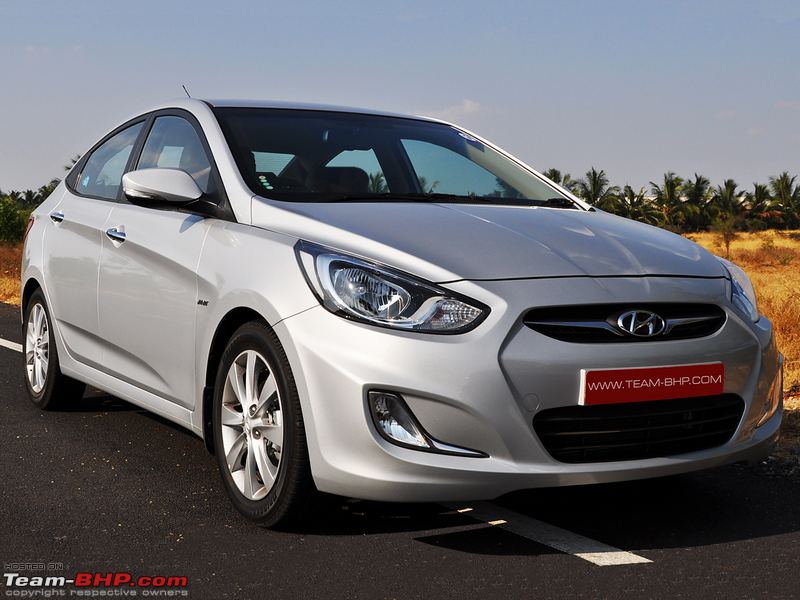| |||||||
| Search Forums |
| Advanced Search |
| Go to Page... |
 |
| Search this Thread |  10,767,982 views |
| | #1 |
| Team-BHP Support  | 4th-gen Honda City : Official Review The Honda City has been launched in India at a price of between Rs. 7.42 - 11.10 lakhs (ex-Delhi). What you'll like: • Practical diesel, fast petrol and convenient CVT. Take your pick • Loaded with equipment (sunroof, feather-touch climate control, keyless entry & go, rear air-con, reversing camera) • Extremely spacious cabin. Loads of sensible touches make it easy to live with • Diesel & Petrol, both, have segment-topping ARAI fuel efficiency ratings • Big 510 liter boot will swallow your airport & holiday luggage • Light controls, slick gearshift and easy maneuverability for the city. Effortless to drive What you won't: • Same diesel as the Amaze. Outright performance & refinement levels are lower than the Verna, Vento & Rapid • Front looks like a mere facelift. Boring alloy wheel design & skinny 175 mm tyres too • Light build quality. Lacks the sheer solidity of its European rivals • Electric steering remains light & sensitive at high speed. No feedback either • 6 footers will find rear headroom to be in short supply • Some features missing (proper dead pedal, folding rear seat, height-adjustable seatbelts, boot lid cladding) The 2017 Facelift: • Link to report 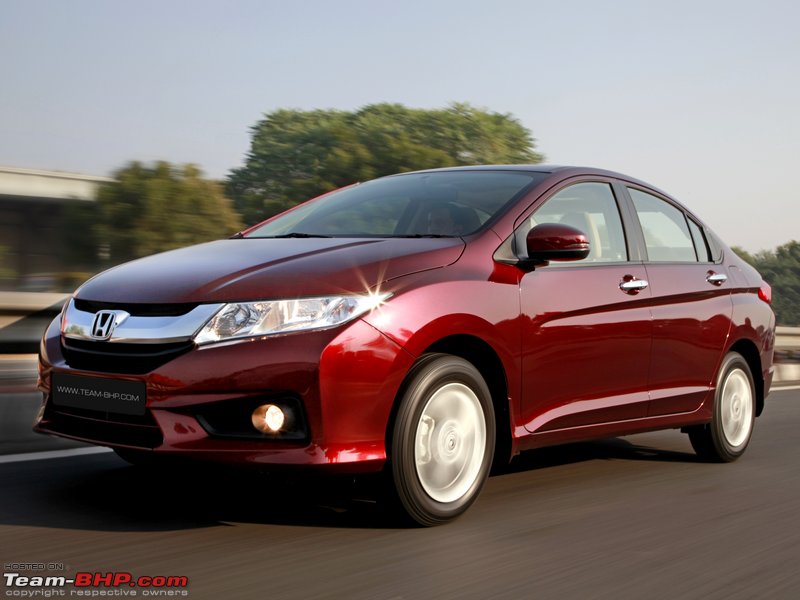 Last edited by GTO : 6th April 2017 at 23:30. |
| |  (98)
Thanks (98)
Thanks
|
| The following 98 BHPians Thank GTO for this useful post: | aah78, amit_zen, Apple, arif_iq, Arjun Reddy, Arun.K, AutoIndian, autonarr, avdhesh15, B747, Baddychat, Bailey, BlazzingInferno, darklord, deetjohn, dkaile, DRIV3R, echo77, ecosport rules, FINTAIL, FlashMustang, frankmehta, Gannu_1, girishglg, graaja, Guna, Guru_Shikhar, haisaikat, iliketurtles, Insearch, J.Ravi, Jeash.vk, jeetaman, JoseVijay, JTM, kryogesh, lemedico, Leoshashi, Marley, Mevtec, MotorDev, mpksuhas, mroptimist, mukeshgoel, neel911, petrolveins, Philomath55, R2D2, Ranjit.Shetty, RavenAvi, reganluis, Rehaan, Rohit Manohar, romeomidhun, Rshreyansh, RSR, S.MJet, SaiSW, sajusherief, saket77, samabhi, sandeepmohan, sapeco, Satshan, saurabhdadhichi, sa_kiran, scopriobharath, sdp1975, Seran Manian, Sheel, shinuak, sidkeenlearner, Simhi, SmartCat, SoumenM, speedfreak01, StarScream, suhaas307, swiftnfurious, Tats07, Technocrat, tejas08, Tejas@perioimpl, theexperthand, thoma, tsk1979, uday.ere, v&v, vaish9925, valapad, vb-saan, venks, vibbs, VijayAnand1, Vik0728, virtualdanger, Voodooblaster, Yeldo |
| |
| | #2 |
| Team-BHP Support  | re: 4th-gen Honda City : Official Review 1998, 1st-Gen City. Cumulative sales of ~60,000:  2003, 2nd-Gen City. Cumulative sales of ~180,000:  2008, 3rd-Gen City. Cumulative sales of ~190,000:  Once again, the 5 year mark brings the next generation City:  In total, Honda has sold about 4.3 lakh Citys in India. The car has been at the top of the segment charts for most of the 15 year run. That's quite an achievement, considering it's petrol-only engine range. In the last 2 years though, steady petrol price hikes and the competent new Hyundai Verna resulted in Honda losing the no.1 position of the C2 segment. Petrol motors are no longer going to single-handedly make the cut, and the competition (especially Hyundai) has raised the bar in terms of styling & equipment. From the current crop of C2 petrol sedans, the outgoing City is still a competent product. Rumour has it that Honda ran out of stocks (of the old City) earlier than anticipated. Hence, it had to pull the 4th-gen's unveiling date closer. Plus, there is no other big launch happening right now. This was probably a better time to bring the City in, than the '14 Auto Expo where it would have to fight for eyeballs with innumerable other unveilings. Not only was this 4th generation City unveiled first in India, but we will also get deliveries before anyone else. No surprise because India surpassed Thailand as the City's biggest market. The new City's face might look similar to the car it replaces; make no mistakes though, it's an all new generation. The 2014 City shares its platform with the new Jazz (due for an India launch in 2014). Unlike the Jazz however, the City is specific to developing countries (primarily south-east Asia) and isn't sold in markets such as USA, Japan, UK etc. Compared to the 3rd-gen, the new car runs the same length & width, is 10 mm taller and gets a wheelbase increment of 50 mm. Where the last 3 generations were completely different from the model they were replacing, the new City is merely an evolution. This conservative approach is similar to how Maruti handled the new Swift, and Toyota the Corolla Altis. The City nameplate enjoys tremendous brand equity in India. With the risky conditions of today, why fix something that isn't broken? Honda has definitely become risk averse in recent times. They played it rather safe with the Amaze' pricing too.   Except for that garish chrome grille, I personally have no problem with the face. It looks clean and wears typically Honda lines. That said, there isn't a doubt that the casual observer will mistake the new car for the old (from the front). There's a definite fluidic influence on the side profile, but it's the rear styling that really stands out. I love the large premium-looking tail lamps, resemblance to BMWs notwithstanding. In person, the City looks more upmarket than the outgoing car. My only complaints are with the boring alloy wheels, skinny tyres and of course, the ungainly chrome grille at the front. Exterior paint, fit & finish are all top class, but it lacks the sheer solidity of the European competition. The City remains a light sedan. In the product briefing, Honda mentioned a couple of weight-saving measures (e.g. lighter suspension components). I didn't pay much attention, until I caught the kerb weights. Even with all that additional equipment, at 1065 kgs the VX variant is a full 45 kilos lighter than the outgoing City's V + sunroof trim level. What's more, due to the low weight CVT, the AT variant is now 75 kilos lighter! EDIT on 28/03/2014: Ownership reports are showing glaringly inconsistent panel gaps (link) which are unacceptable on a Honda. The big news with the City isn't the styling. It's the fact that the model finally gets an oil-burner under the hood. It was common knowledge that the City was going to be powered by the Amaze's 1.5L diesel. What wasn't expected was the City running the same 99 BHP tune! Most of us expected the City's diesel to be force fed by a variable geometry turbo or have a power-inclined remap. Sadly, that's not the case. Honda has chosen to play the fuel efficiency card, retaining the exact same engine specs as the Amaze, save for a different 6-speed gearbox. The 1.6L diesels of the Verna, Vento & Rapid have noticeably more muscle (details in the engine post). Honda claims that, based on owner feedback, a number of weaknesses of the outgoing City have been addressed. Real world ground clearance has improved (specifically mentioned via an infographic in the product presentation), a CD player has been added to the ICE setup, and there is climate control as well. Equipment levels have been significantly enhanced, with the City going from being the most sparsely equipped car to among the best kitted. The VX trim level has a host of features including dual airbags, ABS, smart key entry, engine start / stop button, sunroof, feather-touch climate control, reversing camera, rear air-con, cruise control and more. For a car that's moving up the food chain, I wish Honda had beefed up the safety kit with additional airbags, ESP and rear disc brakes (2nd gen City Vtec had rear discs). Useful features that are conspicuous by their absence are seatbelt height adjustment, a proper dead pedal, folding rear seat, steering reach adjustment and a vanity mirror on the driver sunvisor.  The reasons for the City moving upmarket are twofold. For one, there is the new Amaze at the lower end of the market. Then, the Civic has been discontinued and Honda has no plans to bring in the replacement anytime soon (related thread). The new City is effectively a replacement of two cars, the ol' City and the Civic. Honda is hoping that the City's top variant fills up the void left by the Civic. Some amount of cannibalisation between the top-end Amaze and base City is inevitable, especially since the diesel engine is identical between the two. Taking a leaf out of Maruti's book, Honda probably won't mind as long as the customer remains in the Honda showroom. The company will be trying to differentiate between the two sedans as much as possible (additional equipment, 6th gear ratio etc. are all part of that plan). Interesting to note how Honda has changed its focus to the sub-10 lakh segment, as compared to the time when all of its products (barring the City) were priced 14 lakhs and up. The Brio, Amaze & City are already here. Soon, the Jazz, Mobilio (Brio-based MPV) and Vezel (Jazz-based SUV) will follow. From a single <10 lakh product, Honda India will have 6 in the near future. End of the day, this is where the volumes lie. Plus, it's way too difficult to fight premium European diesels with a petrol-only portfolio. This is the first time that Honda is managing capacity constraints, having recently added a 3rd shift at its UP plant, thereby increasing output to ~13,300 cars / month. The Rajasthan factory will start rolling out cars from the first half of 2014. Rather than an all-new generation, the 4th-gen looks more like a mere facelift from the front. This image shared by nik_kapur shows a striking resemblance to the Modulo kit of the outgoing City. Bonnet is now wider & the bumper sharper:  Fab looking derrière. Styled much like some BMWs we know. Chrome treatment here is better than that at the front:  Side profile is, dare I say, Fluidic! 4th-gen City stands 10 mm taller: 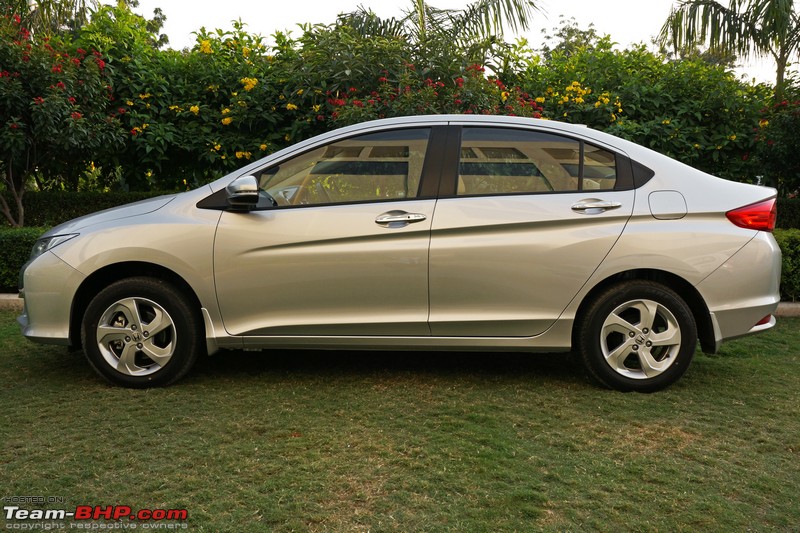 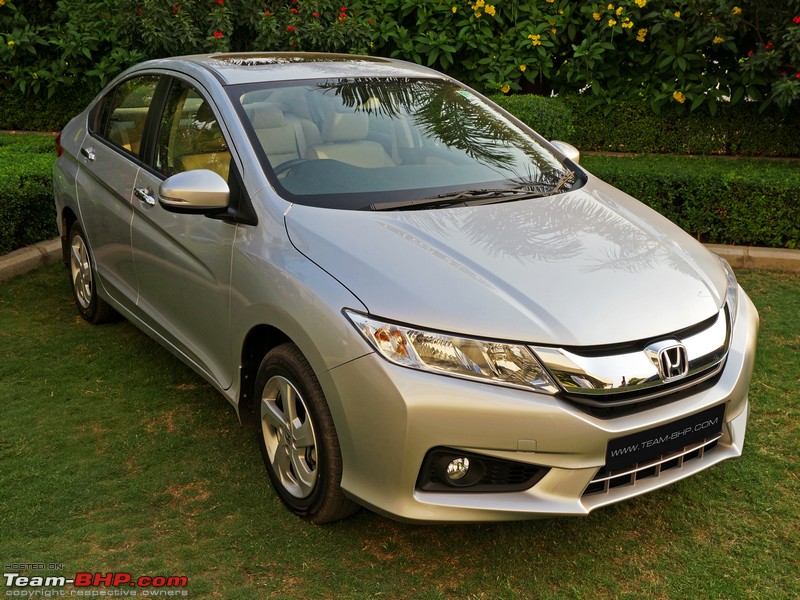 One of my favourite angles to view the car in. Rear is interchangeable with the upcoming Maruti YL1: 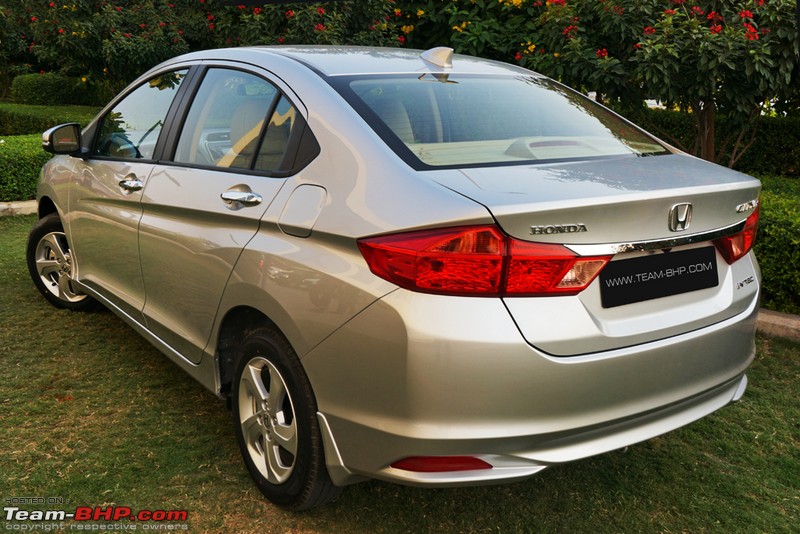 Next to the model it replaces. The ol' City is still a great looking sedan and I prefer its cleaner side profile:  Simple, classy headlamps. Low & high beams are now separate (3rd-gen headlamp pic):  Honda went overboard with this chunky chrome grille. Looks way too cheesy in my opinion...a face with an ungainly moustache. Bet that after-market vendors are already lining up bolt-on replacements:  Round foglamps. Honeycomb surround isn't fragile at all (doesn't bend if pushed), appears durable: 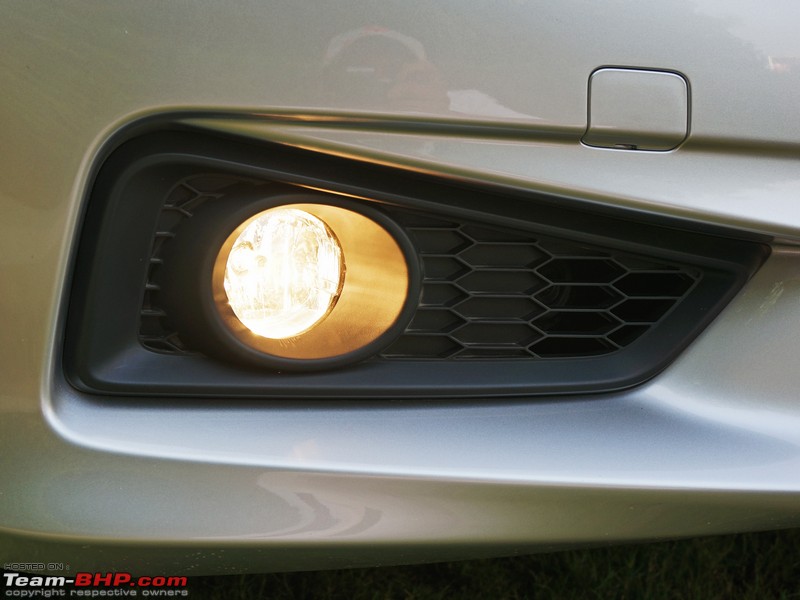 Engine guard is much needed on Indian roads. Will protect against flying debris:  Twin-type washer nozzles, out of view from the front. A wise move. The 3rd-gen City had them placed on the bonnet. No more rusting issues (link):  Horrible choice of rims. Too flat, and a throwback to the nineties. Reminds me of the ones from the Renault Duster (link). Outgoing City surely wore nicer alloys. 175/65 R15 tyres are skinny by segment standards (even the Dzire ZDi is shod with 185s!). For the kind of power that the petrol variant has on tap, 195 mm is the minimum required width. Thin tyres might be chosen for high ARAI ratings. Upgrade recommended for your safety:  Partial cladding in the front wheel well, but absolutely none at the rear due to cost cutting! Looks unfinished & ugly:  Electrically-foldable ORVMs with integrated blinkers: 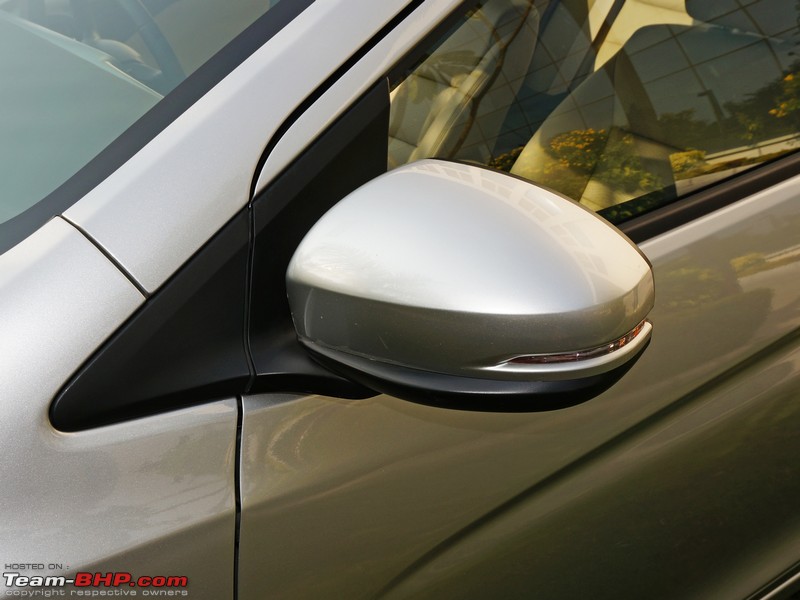 With the smart key in your pocket / bag, all you need to do is press that black request sensor button to unlock the car. Incredibly convenient. Seen here is the passenger-side door handle which gets a request sensor as well:  Top variant is equipped with a sunroof:  Fully open, with the wind deflector at the front:  Sunroof in the Tilt position. Helps with circulation & letting fresh air in. Reduces heat buildup in the summer. Link to Ajmat's useful article on India-specific sunroof tips:  Shark fin antenna on the roof...another BMW touch (the 5's shark fin):  Black plastic insert (behind the rear door) looks awful. Is it an afterthought? 3rd-gen City didn't have it:  Smart, large rear tail-lamps:  Reversing camera is placed right above the number plate. Clearly visible from the rear, unlike the seamless integration of some other cars. I found myself looking for & fumbling with the 'boot open' button (to the right of the camera), even after spending considerable time with the City:  Rear bumper sits nearly flush with the boot lid. Should have extended out some more for protection. Expect to see a lot of Citys with dented boots: 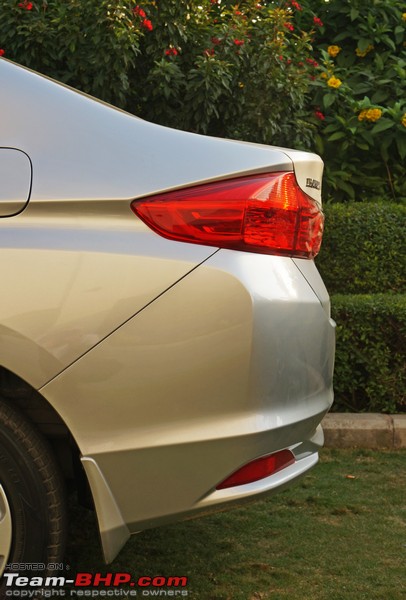 Skinny tyres. Wider rubber will not only improve overall dynamics, but also enhance the car's stance. No chrome tip for the exhaust:  Conventional fuel tank location below the rear bench. The 2nd & 3rd gen Honda Citys had it located under the front seats, as does the Jazz (on which this City is based):  Look closely and you'll notice a slight difference in the CITY badge (earlier version). The "Y" cuts into the "T" here. Top variant's nomenclature (i.e. VX) now similar to the Amaze, compared to the earlier City's "V":  Last edited by GTO : 28th March 2014 at 14:51. Reason: Adding point on panel gaps |
| |  (83)
Thanks (83)
Thanks
|
| The following 83 BHPians Thank GTO for this useful post: | Abhinav V, akshay81, amitwlele, amit_zen, Anand123, Apple, Arjun Reddy, AutoIndian, avdhesh15, B103, Baddychat, Bailey, BlazzingInferno, bsdbsd, cpbopanna, deetjohn, Digital Vampire, dkaile, echo77, ecosport rules, frankmehta, Gannu_1, girishglg, graaja, iliketurtles, InControl, iPai, J.Ravi, JoseVijay, kadanaJ, kryogesh, manim, Max, Mevtec, MotorDev, mroptimist, Navneet, noopster, PGNarain, Ponbaarathi, prakhar1998, R2D2, rajesh1868, Ranjit.Shetty, RavenAvi, Rehaan, Reinhard, RJ2285, Rohit Manohar, romeomidhun, rshanker, RSR, S.MJet, saket77, samabhi, sapeco, Satshan, saurabhdadhichi, sayakc, sa_kiran, scopriobharath, SDP, Sheel, Simhi, SmartCat, stormerider, suhaas307, sumitgovil2311, swamyzen, swiftnfurious, Tats07, Technocrat, tejas08, theexperthand, uday.ere, vaish9925, valapad, vb-saan, vibbs, vredesbyrd, wilful, Yeldo, yosbert |
| | #3 |
| Team-BHP Support  | re: 4th-gen Honda City : Official Review  Between the 2nd & 3rd gen Citys, it was the former that had the better interiors. Honda realised that interior ambience is important to Indian customers, and the 4th-gen reflects that line of thought. On the inside, the new City feels significantly more premium than the car it replaces. For one, cabin space has further improved. The additional equipment helps the cause too; a superb steering wheel, feather-touch climate control, audio display & reversing camera, engine start / stop button, loaded instrument console, sunroof, leather seats etc. all make the car feel substantial. The interior theme (black, beige, silver) is classy, while some sections get a piano black finish as well. Touches of chrome have been tastefully applied on the air vents, strips below the climate control and above the audio....the chrome is minimal and understated. Most parts feel durable and of satisfactory quality. No, there's no soft touch material in here though. The City might be moving up the food chain, yet interior finesse isn't comparable to the erstwhile Civic. For instance, the doorpads are rather rudimentary. The gear lever, shod in plain black leather, looks way too spartan. Even the Amaze gets a superior black & silver gearknob. The dash definitely suffers from asymmetry. In that, it lacks cohesiveness. This must be the only car on sale with 3 different types of air vents on the dashboard, all placed at varying heights. Further, the leftmost vent has its air flow control on the side, while the rightmost has it below. The positioning of the engine start / stop button seems like an afterthought; it should have been placed a level up (on the piano black area). Then, the rectangular hazard light switch appears to be in no man's land! I like the idea of an all-black dashboard, but detest all-beige carpets for Indian conditions. They're simply not practical, and will get easily soiled. As with most Hondas, the seats are on the lower side & you need to bend down to sit on them. It's not a cakewalk for the elderly, like in the SX4. Thanks to the generous greenhouse and beige interior colour, the cabin feels really bright & airy. The top variant's sunroof allows even more light inside, although it has a sliding cover if the weather gets too sunny. The leather upholstery is nice and cushiony. I like the quality of leather used. The seat is absorbent and it's center area is perforated (helps with air flow & keeping the seat cooler on a hot day). Those checking out the car at showrooms will love the soft seats. However, it's important to understand that a firm seat compound provides superior support on long highway drives. The front seats have a nice 'bucket-like' feel to them, providing good lateral support. Underthigh support is average unless you crank the seat height up. The cabin has ample width at the front. Two hefty occupants won't be elbowing each other. The seat height adjustment has a large range and will easily accommodate the shortest of drivers without complaint. On the flip side, those buying lower variants (sans this feature) must crosscheck frontal visibility. The stock seat is placed low and I'm pretty sure the dashboard top will block visibility for shorter drivers. On a related note, the front seats don't travel all the way back as in European cars. The range seems quite restricted. The lateral view is excellent, helped in no small part by the large windows. On the other hand, rearward visibility is pathetic due to the parcel tray's horribly high position. Those buying variants without reversing cameras are advised to install parking sensors. The ergonomics are spot-on, making the cabin incredibly user friendly, and the center console is angled toward the driver. The thick, compact steering feels premium and is a delight to hold. The large integrated controls (phone, audio, cruise control) are easy to operate. In fact, most buttons on the inside of this car are from the "L" size part bin and thus, practical to live with. The steering has tilt adjustment, albeit nothing for reach (Vento offers it). Honda claims that the tilt adjustment range has improved over the 3rd-gen City. There is a center armrest for the driver and it's acceptably comfortable to use. The footwell is wide enough and the pedals are properly spaced out. There is no dead pedal though and Honda's poor excuse for one (in the MT variant) is useless. Thankfully, there is enough room to rest your left foot. The CVT automatic doesn't get a proper dead pedal either, but it's makeshift arrangement is far superior than the MT's. Big fonts make the instrument console effortless to read during the day. There is some reflection under direct sunlight, yet the font size takes care of readability. You rarely need to look twice at the meters. Real-time fuel economy is displayed via a progressive bar. This is surely easier to catch on the go than a digital counter. Party trick : the ambient lighting around the speedometer changes its colour from blue to green if you drive in a fuel-efficient manner (basically, with a light right foot). The MID provides the usual data set, including a distance-to-empty counter and average fuel economy. What I found particularly nifty was the individual 'average FE' calculation for each of the tripmeters. No temperature gauge provided and over 90% of us are going to miss it (related thread). The factory audio system has 8 speakers. Each door carries a speaker & tweeter, both. The head-unit will accept music from any of the popular sources, be it CD / MP3 / USB / AUX / Bluetooth. We played MP3s through a smartphone and found the sound quality to be excellent by OEM standards. There's good bass at the front, while the tweeters make a welcome difference to sharpness levels. Like most factory systems, this audio focuses primarily at the front. The rear speakers are weaker and lack the required bass. I doubt too many City owners will be upgrading their systems in the after-market. No issues with reading the head-unit display over the course of the day either. Equally, I must add that the 3rd-gen City's factory fitted AVN head-unit was superior (close look here). Among other things, the previous generation offered a touchscreen interface, navigation, DVD player and remote control. Honda faced a lot of flak for not equipping the old City with climate control. Well, here's their answer: A segment first touch-panel interface. I had apprehensions on its usability, but faced no issues at all when test driving. All controls are adequately spaced out and there's no chance of confusing one button for the other. A light tap on the panel is all that's required to send your command, and the system responds with a confirmation beep for each input. This climate control interface is definitely cool to use. The single disadvantage is the need to take your eyes off the road to change settings, something that a physical knob doesn't require. The air-con blower has 7-speed adjustments. A Rajasthan winter is hardly the best time to test out an air-conditioner, but if history is anything to go by, you won't have any problems with Honda's cooling hardware. The City offers 4 charging points for your smartphones & laptops. There is one 12v socket at the front, along with a USB charging / audio port. Rear passengers get two 12v sockets under the air-con unit. All 4 doors can hold 1 liter bottles. Plus, there are two cupholders at the front as well as rear of the cabin. The map pockets of the front doors are way too thin; those with fat fingers will have trouble lifting anything out of there. The glovebox is accommodating, while the driver armrest covers a storage cubicle to place your wallet in. There is another useful storage drawer on the RHS of the dashboard. Around the handbrake area are open slots to park your smartphone & the like. Both front seats get wide seatback pockets. Chunky steering wheel is just the right size, great to hold. Feels premium. Tilt adjustment only. You need to stretch your thumbs a bit to honk:  Large audio / phone / cruise control buttons are practical. No mute button:  Press phone buttons from the back (not the front). The rear of these buttons have a recessed area where your finger slides in:  Great looking blue-ringed instrument console, and a pretty loaded MID. Easy to read, despite some reflection observed during the day. Unfortunately, an engine temperature gauge isn't provided. Cruise control sign lights up when activated. Petrol's redline starts @ 6,800 rpm:  MID has a distance-to-empty counter, clock, outside temperature and independent average FE readings for each of the two tripmeters (not shown here):  That graphical bar displays real-time fuel economy. It hovers between 0 - 30 kpl, based on your driving style. Far easier to read on the go than a numerical counter. Some people enjoy seeing the rpm needle go high, others will take pleasure in playing with this one:  Literally sticking out like a sore thumb. This ugly stalk (on the instrument console) is used to toggle through MID views and also dim the console + ICE display + climate control. Note that the dimmer works only in night mode (i.e. when the headlamps are on). The displays have a fixed illumination level for the day:  Sweet engine start / stop button is a welcome addition. With the smart key in your pocket, press the clutch and hit this button to fire up the engine. Press it without the clutch to access audio & 'ignition on' modes:  Feather-touch climate control looks über cool. Easy to use too. A light tap is all that's required. Different controls are well spaced out, and the system responds with a confirmation beep for each input. Party trick: Swipe to max out / minimise blower and temperature settings. Downside? You need to take your eyes off the road to change any setting:  Thick control stalks are standard fare:  Bucket-like front seats with perforated leather in the middle. Driver armrest is decent, although it's not adjustable:  Sunroof helps in keeping the cabin bright & airy. Shut the sliding blackout cover if it gets too sunny:  Driver's seat height adjustment has a healthy range. Max / minimum levels shown here. Short drivers will need to crank it all the way up: 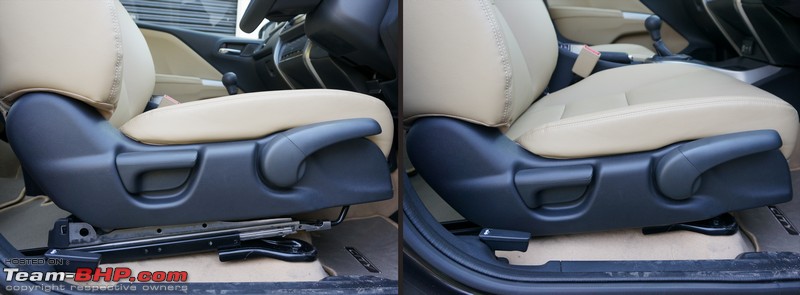 No empty space under the front seats, unlike most other cars. Why the raised floor section? The Jazz - on which the City is based - has its fuel tank located below the front seats. Also notice the thin seat base which is obvious in this image:  Plain-Jane doorpad lacks character. Each of the 4 doorpads can hold a 1 liter bottle and is home to one speaker + tweeter. Believe it or not, the driver's doorpad flexes outward when you roll the window down, and inward when the glass is moved up:  Driver's window has the auto up / down functionality:  Mirror controls move to the dashboard (RHS). Electrically foldable ORVMs are useful. They don't auto-fold as you lock / unlock the car though. Hopefully, this feature can be activated at the dealer level (as is the case with many cars):  The ORVMs should have been a size wider. They don't cover the action behind as well as I'd like:  ABC pedals are adequately spaced out. Fake dead pedal is useless on the MT, but better on the CVT automatic. Thankfully, there is enough room to rest your left foot. Unlike in the 3rd-gen City, the clutch pedal doesn't overlap the fake dead pedal:  Weird placement for the fuel lid release, right above the one for the bonnet. I'm willing to bet many will unintentionally open the fuel lid when they actually intended to release the hood. 3rd-gen City had a push to open / close style fuel lid (no lever inside the cabin):  Not merely hooks; the driver's mat is held in place with these rotary locking clips. Neat touch: 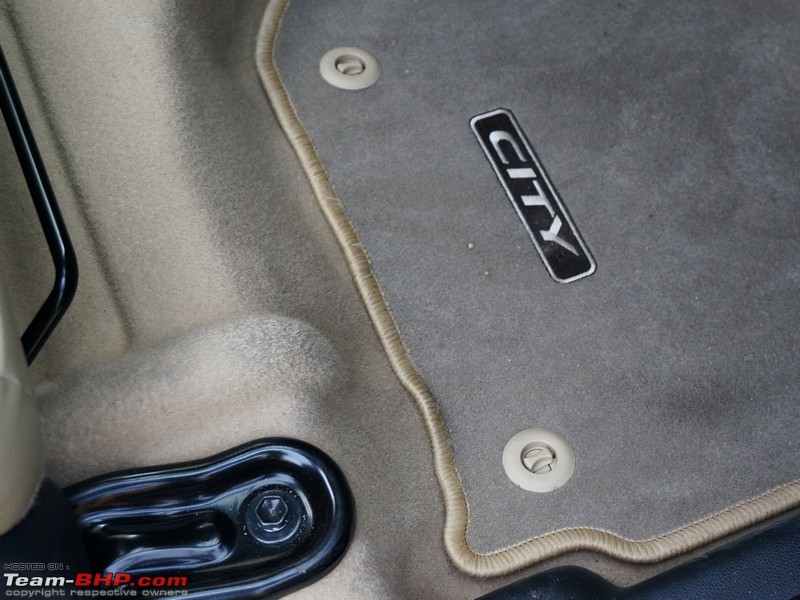 The useful seatbelt height adjustment is missing in an otherwise loaded car! Shocking, when you consider the 3rd-gen City had this feature:  Nifty storage box under the driver's armrest. Carpeted base too. 4.5" smartphone placed to illustrate the size:  Storage cubicles around the handbrake. Those rectangular slots are good to park 4.5" smartphones, but not phablets: 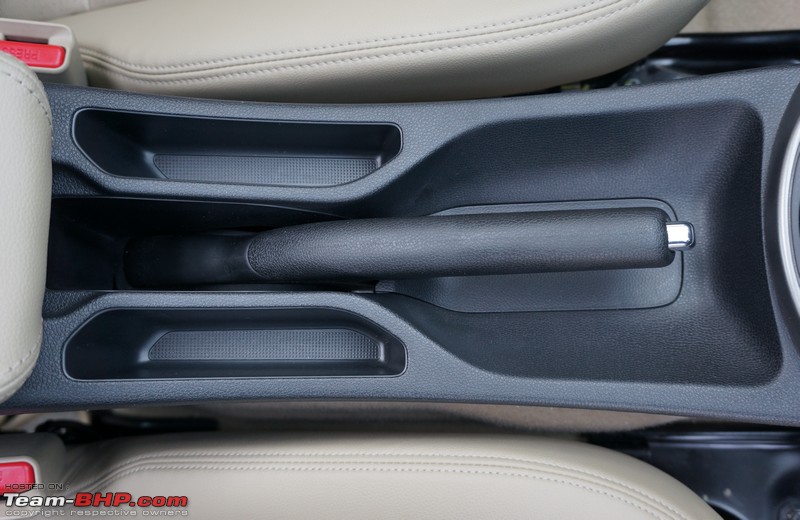 Two cup-holders and the power / audio sockets are located right ahead of the gearshift. Integrated ports are nicer than the dangling USB wire of the outgoing City:  Simple looking glovebox is accommodating:  Two cabin lamps and the sunroof controls, above the rearview mirror:  Passenger-side sunvisor has a vanity mirror, driver's side gets absolutely nothing. Quite surprising as the cheaper Amaze is equipped with mirrors on both sides (image link). What makes matters worse is the driver's side roof molding has a recess for the missing mirror! Clearly an error by the product planning department:  The parcel tray's unusually high placement results in poor rearward visibility. Owners will be putting that reversing camera to good use:  Last edited by GTO : 31st December 2013 at 15:04. |
| |  (77)
Thanks (77)
Thanks
|
| The following 77 BHPians Thank GTO for this useful post: | Anand123, Apple, arishi1, AutoIndian, autonarr, avdhesh15, Baddychat, Bailey, BlazzingInferno, bsdbsd, cosmos, Desmosedici, dkaile, DRIV3R, driving_smartly, echo77, ecosport rules, Gannu_1, girishglg, hiren.mistry, hmansari, InControl, Insearch, iVento, J.Ravi, jailbird_fynix, JoseVijay, kryogesh, Leoshashi, lloydofcochin, loving_alaap, Mevtec, MotorDev, mroptimist, neel911, noopster, prakhar1998, R2D2, Ranjit.Shetty, RavenAvi, Rehaan, rjalihal, Rohit Manohar, romeomidhun, rshanker, Rshreyansh, RSR, S.MJet, saket77, samabhi, sapeco, Satshan, sayakc, sa_kiran, scopriobharath, SDP, Sheel, Simhi, SmartCat, suhaas307, sumitgovil2311, swiftnfurious, Tats07, Technocrat, Tejas@perioimpl, theexperthand, ToroRosso, uday.ere, vaish9925, valapad, vb-saan, vibbs, VijayAnand1, Viju, Voodooblaster, W.A.G.7, yosbert |
| | #4 |
| Team-BHP Support  | re: 4th-gen Honda City : Official Review The rear door opens out wide, allowing for easier ingress & egress (still, remember my earlier comment on the low seating). Additionally, the gap between the B-Pillar and the seat is healthy. The 3rd-gen City was anyways the most spacious from the C2 segment. This 4th gen takes that advantage further. Legroom has so obviously improved and cabin space is now comparable to some cars from a segment above. Two 6 footers will comfortably sit one behind the other. With the front seat pushed all the way back, I (5'10") still had some knee clearance from the front seat! There are sedans in the market that are longer than the City, yet can't match this kind of space. Intelligent packaging at its best, really. The backrest has a comfortable recline angle and runs long enough to support the entire spine. While back support is good, underthigh support is satisfactory only for those of short - medium height. Tall passengers will wish for more of a base, although matters are far better than in the Verna. Just like the front seats, here too, the leather upholstery is soft. Good for short drives, but not for marathons. Rear seat passengers don't get adjustable neck restraints. Instead, what they have are the fixed variety with a soft compound. These are more like small pillows to bury your head into. What tall passengers will complain about is the headroom. It's at a serious premium in here, due to the swooping C-pillar. I had merely an inch of clearance from the roof! A 6 footer will most certainly brush his head against the ceiling. The soft center armrest is functional, while the door armrests are broad enough to accommodate your forearms. Chauffeur-driven City owners will appreciate the rear air-con unit which has two adjustable vents. You can also control the amount of air flow. The air-con unit is perfectly designed and doesn't intrude into the legroom. The Renault Duster has a thing or two to learn here. The floor area, where you rest your feet, slopes upward (the Jazz on the same platform has its fuel tank under the front seats). I found this arrangement to be very comfortable. It's unlike conventional cars where your feet are placed on a flat floor. Vertical space isn't much; those with XL size boots will find it insufficient. The rear seat is positioned a tad higher than the front. That, combined with ample glass area, makes for a bright ambience at the back. The windows are large and their sills aren't too high either. Rear passengers can make use of two reading lamps & two 12v power sockets. Things aren't as smooth for the 5th occupant. There is a slight hump in the center of the rear seat, thus the 5th passenger sits higher than the others. He'll only have support for the middle area of his back, and none for the side. Because he sits taller, headroom is even more limited. Thankfully, the floor hump isn't too prominent. When a group of 5 are out for a long drive, you can be sure that the 5th occupant will swap seats with others, ever so often. The new City has the biggest boot in its segment @ 510 liters. Honda says that the upper floor is good for 485 liters, and the under floor for 25. Additionally, the boot has a practical layout. It's deep, wide and runs long enough. Your family's holiday luggage will be swallowed in without issue. Unfortunately, the rear seat is fixed and doesn't fold down. This greatly reduces cargo flexibility. Just like at the front, rear doors also get a 1 liter bottle holder, small door pocket and speaker + tweeter combo. Armrest is usable. Rear speakers are nowhere as powerful as those at the front:  Exceptional space, more than some D1 European sedans too! Shown here is the maximum / minimum legroom:  With the front seats pushed all the way back. I could still sit on the rear bench...with some legroom to spare. Underthigh support is good for short - medium occupants. Tall passengers will want more:  Comfortable backrest angle. Center armrest is soft and has two differently-sized cupholders (for a medium & large coffee cup). Fixed neck restraints are more like small pillows to bury your head into:  Rear air-conditioner does make a difference. Two individually-adjustable air vents (for direction). Common air volume control:  Two power outlets for the smartphones & laptops of rear passengers:  The floor area slopes upward (same reason: the Jazz has its fuel tank under the front seat). I found this inclined floor to be comfortable. Vertical space for large boots is insufficient though:  The ugly, raised parcel tray. You can also gauge the limited headroom from this picture:  Flash used intentionally to highlight the raised portion of the seat, where the 5th passenger sits. Things are far from ideal for him:  Floor hump isn't obtrusive like in the VW Vento:  Two wide & spacious seatback pockets. Notice how the bottom 2/3rd of the seatback is scooped in to release additional kneeroom:  Dual reading lamps for rear passengers:  Spring-loaded grab handles. Unit at the rear right gets a coat hook:  Dimensions comparo with the 3rd-gen City:  Best-in-class 510 liter boot will effortlessly swallow your holiday luggage. Wide loading bay too:  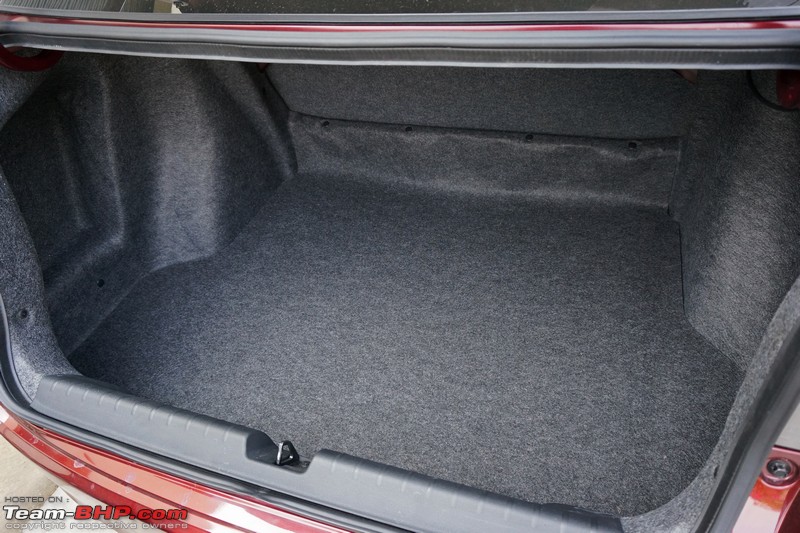 Boot lamp at the top. Sadly, the rear seat doesn't fold down. This limits cargo flexibility in Indian households where a single car has to play multiple roles: 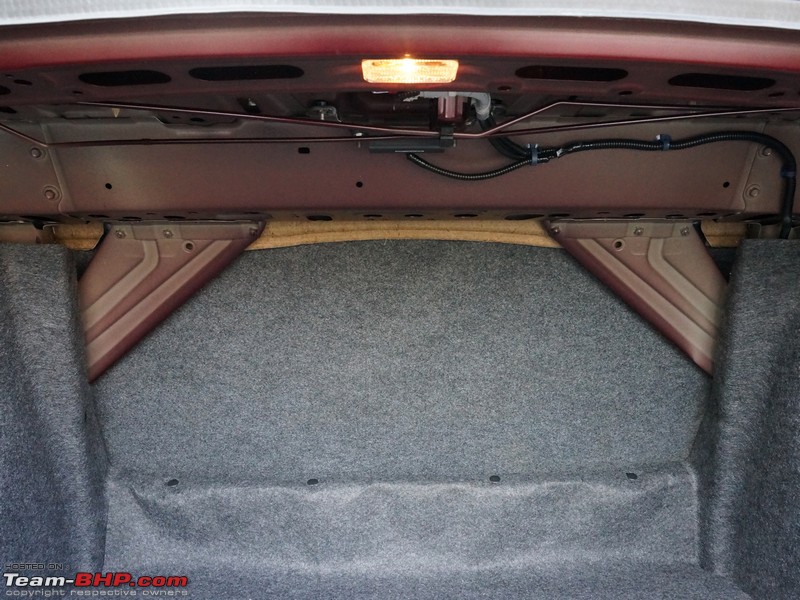 Spare wheel isn't an alloy. The Amaze's tools are organised in a thermocol kit (image link). The more expensive City gets a cheaper rexine pouch. Why?  The inside of the boot lid is naked! Cover sorely missed. Cables & boot-opening mechanism look pathetic: 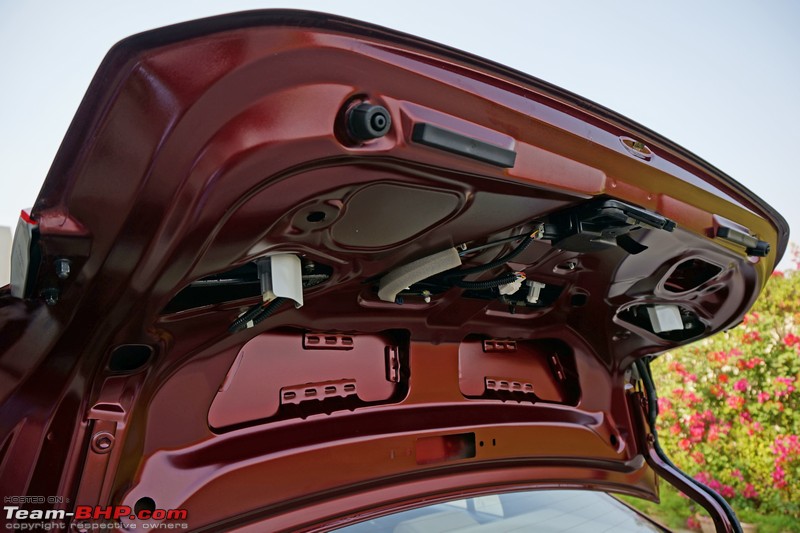 Last edited by Rehaan : 18th December 2013 at 23:29. |
| |  (58)
Thanks (58)
Thanks
|
| The following 58 BHPians Thank GTO for this useful post: | akshay81, Apple, arishi1, AutoIndian, avdhesh15, Bailey, BlazzingInferno, bsdbsd, dkaile, dreamseller, ecosport rules, Gannu_1, hmansari, iliketurtles, InControl, Insearch, J.Ravi, JoseVijay, lloydofcochin, manim, mbz180, MotorDev, mroptimist, noopster, prakhar1998, R2D2, RavenAvi, Rehaan, Rohit Manohar, romeomidhun, Rshreyansh, RSR, S.MJet, sagarrungta, saket77, samabhi, Satshan, saurabhdadhichi, sayakc, sa_kiran, scopriobharath, SDP, Simhi, SmartCat, suhaas307, swiftnfurious, Tats07, Technocrat, tharian, theexperthand, ToroRosso, uday.ere, vaish9925, valapad, vb-saan, vibbs, Vik0728, yosbert |
| | #5 |
| Team-BHP Support  | re: 4th-gen Honda City : Official Review Head-Unit & Reversing Camera The reversing camera has 3 viewing options. Wide view:  Normal view. This was while backing up in a dark area, with the reversing lamps effectively lighting up the area:  Top down view:  You can choose from various camera settings; brightness, colour and whether the guideline displays or not (it doesn't move with steering input):  A closer look at the tweeter on each door:  5" head-unit display shows album art, track number, song name, album & artist. It's not a touchscreen:  You can hook your phone up via bluetooth. Speed dial, access your contacts and more. Outdated interface is straight out of the nineties:  It's possible to import a custom wallpaper. Want a Team-BHP wallpaper? Click here (wallpapers links):  Switchable colour themes:  Individual settings for day & night brightness levels:  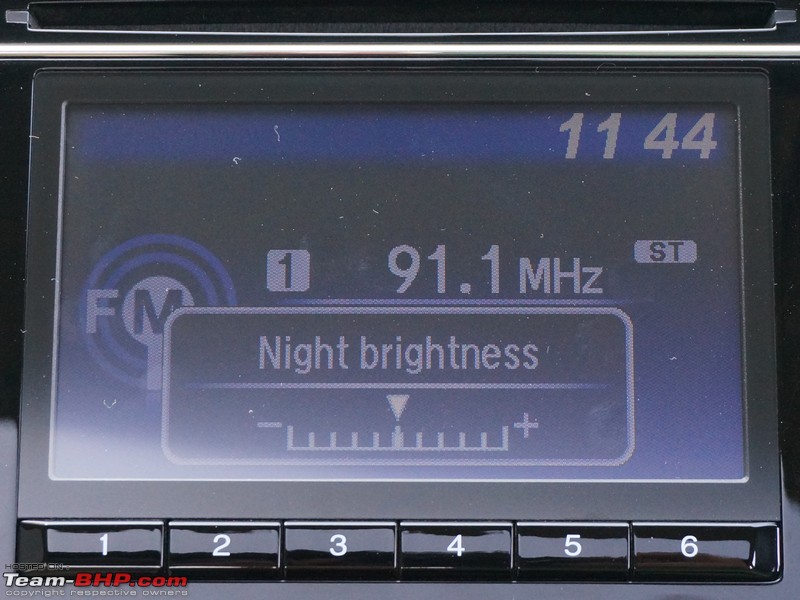 Last edited by Rehaan : 18th December 2013 at 23:30. |
| |  (58)
Thanks (58)
Thanks
|
| The following 58 BHPians Thank GTO for this useful post: | akshay81, Apple, arif_iq, AutoIndian, autonarr, avdhesh15, Baddychat, Bailey, BlazzingInferno, cosmos, dkaile, ecosport rules, Gannu_1, girishglg, Hayek, hmansari, InControl, Insearch, J.Ravi, JoseVijay, manim, MotorDev, noopster, prakhar1998, R2D2, Ranjit.Shetty, RavenAvi, Rehaan, Rohit Manohar, romeomidhun, rshanker, Rshreyansh, RSR, S.MJet, saket77, samabhi, Satshan, sayakc, sa_kiran, Sheel, Simhi, SmartCat, suhaas307, sumitgovil2311, swiftnfurious, Tats07, Technocrat, Tejas@perioimpl, tharian, theexperthand, uday.ere, vaish9925, valapad, vb-saan, vgsr, vibbs, Voodooblaster, yosbert |
| | #6 |
| Team-BHP Support  | re: 4th-gen Honda City : Official Review Honda's 1.5L i-DTEC Diesel Engine • This is the 4th Honda diesel ever, and the smallest yet. The 1st was the 2.2L i-CTDi in 2003, 2nd was the 2.2L i-DTEC in 2008 and the 3rd was the recently unveiled 1.6L i-DTEC • 1,498 cc. 4 cylinder, double overhead camshaft 16v motor • 99 BHP @ 3,600 rpm • 200 Nm torque @ 1,750 rpm  • 26 kpl fuel economy rating (under ideal test conditions) is the highest of any Indian car (the Amaze diesel is next @ 25.8 kpl). The City is heavier, but it's 6th gear ratio allows 200 more meters on a liter of diesel 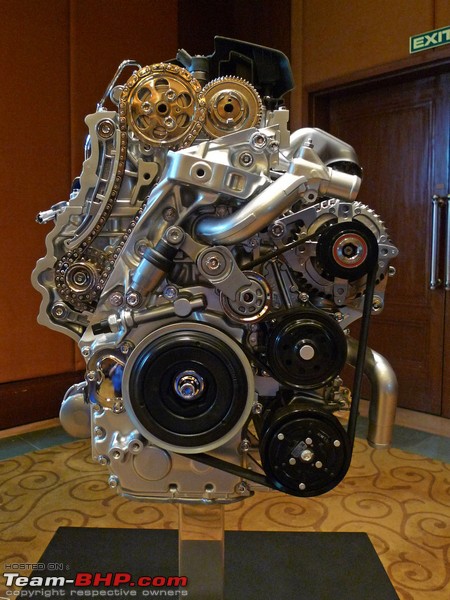 • Fixed geometry turbocharger made by Honeywell • 1600 bar injection pressure • Same block as Honda's 1.6L diesel (available internationally) with common internals, but a reduced stroke to bring down the displacement to <1,500 cc (for Indian tax benefits). Engine development work started in 2007 • Engine ancillaries (e.g. water pump) have shrunk from the 1.6L motor  • 1.5L diesel weighs 152 kgs. Lightest diesel engine compared to those with similar power ratings. It's heavier than the 1.3L MJD though (~130 kilos) • Service interval of 10,000 kms / 6 months  • Despite Honda's earlier complaints of Indian fuel quality, this engine has been tested extensively with poor quality diesel and it ran just fine • A resin fuel strainer is fitted in the diesel engine • Features an aluminium head, high strength narrow crankshaft, lightweight pistons and high swirl + high flow rate head design 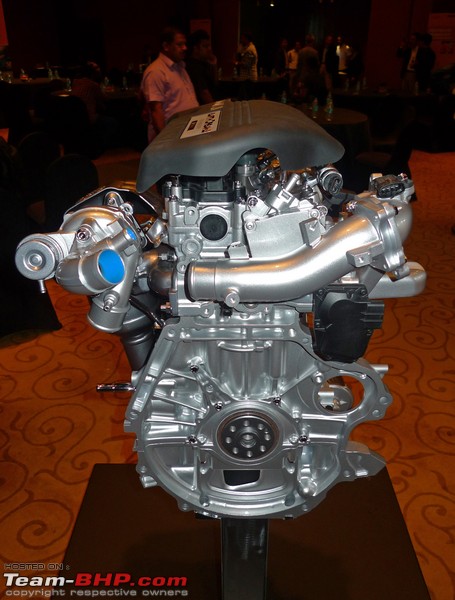 • Engine is mounted on liquid-filled mounts, instead of rubber units, to reduce vibration • 1.5L diesel manufactured at Honda's new engine plant at Tapukara, Rajasthan  • BS-4 compliant. A DPF (diesel particulate filter) can be added in the future to make it BS-5 compliant  • Mechanical friction (@ 1,500 rpm) is similar to petrol engines. Honda claims friction levels are lower than other diesel engines  • Uses ultra low viscosity semi-synthetic oil. Honda co-developed this engine oil with Idemitsu and JX Oil, Japan. Honda claims this is the lowest viscosity oil in the world, but didn't share the exact viscosity grading  Last edited by GTO : 17th December 2013 at 17:28. |
| |  (47)
Thanks (47)
Thanks
|
| The following 47 BHPians Thank GTO for this useful post: | akshay81, Apple, AutoIndian, autonarr, avdhesh15, cosmos, ecosport rules, Gannu_1, hmansari, InControl, Insearch, J.Ravi, JoseVijay, jvm_1986, kryogesh, manim, Max, MotorDev, noopster, prakhar1998, R2D2, RavenAvi, Rehaan, romeomidhun, Rshreyansh, RSR, S.MJet, sagarrungta, SaiSW, Satshan, sayakc, sa_kiran, scopriobharath, SmartCat, suhaas307, swiftnfurious, Tats07, Technocrat, Tejas@perioimpl, theexperthand, ToroRosso, uday.ere, vaish9925, valapad, vb-saan, vibbs, yosbert |
| | #7 |
| Team-BHP Support  | re: 4th-gen Honda City : Official Review Driving the 1.5L Diesel MT 1.5L diesel fills the engine bay up:  99 BHP & 200 Nm of torque on tap:  Diesel gets insulation under the bonnet:  The i-DTEC's 6-speed gearbox. Full black gearknob lacks design flair. Should've had some silver (like the Amaze) to break the monotony:  As opposed to the Honda petrols we know, this 1.5L i-DTEC diesel focuses entirely on low-end power delivery. Simply put, in-city driveability is outstanding. Turbo lag is nearly inexistent, with the diesel motor responding well from idle rpms itself. That also means there is none of that sudden punch at 1,800 - 2,000 rpm. The engine has an incredibly tractable nature and within town, you only need to give it light accelerator inputs to potter about. The 1.5L moves away from crawling speeds in 2nd without breaking into a sweat, and even clears the 2nd gear speed-breaker test with flying colours. Throttle response at <2,000 rpm is satisfactory, unlike some of its competitors who are still waiting for the turbo to start spooling. When driving in slow traffic, we are constantly shifting between the 1st & 2nd ratios, and this is exactly where the City has an advantage. The initial lot of gear ratios appear to be identical to the Amaze's. In-city driveability is a highlight of the engine. Although you feel the i-DTEC generating peak torque past 1,800 rpm, there is none of that turbo kick that the Vento & Rapid give you. Honda should have equipped this engine with a VGT (variable geometry turbo) or at least, tuned it for more punch. As things stand, power & torque to weight figures are more in line with the C1 segment than C2. In a straight drag, the Verna, Vento & Rapid will leave the City diesel for dead. There is no competition. On the open road, performance can best be termed as 'adequate' by segment standards. With a torque-to-weight ratio (172 Nm / ton) that's lower than even the Dzire, the City diesel isn't going to be burning down any expressways. The Vento TDI is capable of leaving a smile permanently plastered on your face. That's not the case with the City i-DTEC which is more suited to a regular style of driving. Don't get me wrong; acceleration is decent and the City is capable of travelling at 3 digit speeds all day. The Amaze's top speed was limited to ~145 kph. No such limiter on the City, with Honda claiming a top whack of 190 kph. It's just that you expect something special when spending 10 lakh rupees. That's missing in this diesel. This motor isn't as high-rpm friendly as the others either. The i-DTEC revs to a maximum of ~4,450 rpm (VW & Hyundai diesels easily cross 5,000). In the City, there's no point in taking the rpm that high, and it's best to upshift at 4,000 tops. For all other purposes, the car will do the job. Climbing up steep inclines is an effortless exercise. Because of the absence of turbo-lag, overtaking traffic is a straight forward affair (but not as quick as in the VW & Skoda). The Honda's 6th gear ratio results in 100 kph being seen at merely 2,000 rpm, thus making the car well suited to long distance cruising (related thread. Fuel economy is of a tall order too. At 26 kpl, the City's ARAI rating is the highest of any car on sale in India. Engines with minimal turbo-lag perform well on the fuel efficiency front. Amaze diesel owners report a consistent 16 - 18 kpl in urban conditions, and the City won't be any different. The mass market wants 'average', so Honda's decision of focusing on FE makes business sense. Equally, I must add, the Vento does combine performance with economy, doesn't it? With the Brio, Amaze (both engines) and City petrol, Honda offers amongst the most powerful engines in their segments. The City diesel is a departure from that positioning. The small, short throw 6-speed gearbox is nice to use. It does feel notchier than what I remember of the Amaze. Additionally, the gap between 3rd & 5th is narrow. It might take you a while to get completely used to the gearbox and avoid mis-shifts. The clutch isn't as light as that of the City petrol, yet it isn't a pedal I'd call heavy and complain about either. It's par for the course in terms of effort required. An area where the City disappoints is NVH. Honda says that insulation has been beefed up and the window glass has been made thicker, but clearly that's not enough. The engine is very audible inside the cabin, even at an urban revv range of 1,800 - 2,000 rpm. What makes it worse is the crude, unpleasant engine note. On the move, the diesel motor always makes its presence felt. A Honda techie stated that aluminium diesels are inherently noisier. Another major disadvantage of the City diesel is the significant amount of engine & drivetrain movement felt on the pedals. These vibes are felt not only on the clutch, but even on the accelerator. It's directly proportional to engine rpm. The experience takes away from the refinement you expect in a Honda. Of course, other than the pedals, vibrations aren't present anywhere else in the cabin and passengers won't be complaining at all. Still, the Verna's smooth diesel is in a different league altogether. Driving the 1.5L Petrol MT 1.5L petrol doesn't fill up the engine bay like the diesel. Lots of room to spare:  No bonnet insulation for the petrol. Doesn't need it either:  Notice the engine's protection cover, at the bottom:  Firewall is adequately insulated:  5-speed petrol MT is smoother than the diesel's 6-speed:  The 1.5L petrol is the diametric opposite of the diesel. It's very fast and very smooth. This SOHC engine is the same as that of the 3rd-gen City, with some improvements thrown in. The changes include different valve timing, EGR (after CAT), low tension oil seals, integrated resin intake manifold, lower friction pistons (zigzag pattern coating) and double-needle spark plugs. The cooling system has been modified with the objective of warming up the engine quickly (after a cold start). The sooner you reach operating temperature, the higher will be your fuel economy. In its latest avatar, the 1.5L petrol makes 117 BHP (@ 6,600 rpm) and 145 Nm of max torque (@ 4,600 rpm). Compared to the outgoing car, that's a 1 BHP gain as well as 1 Nm of torque loss. The new City makes its max torque at 200 rpm lower. Because the new car is 45 kilos lighter, there is a marked improvement in the power / weight ratio (109.9 BHP / Ton vs 105.5 BHP / Ton). And this is the fully-loaded VX variant we are speaking of, lesser trim levels will enjoy an even better power-to-weight. Fire the petrol up and the refinement is immediately obvious. It's very silent at idle. In fact, at regular driving speeds, you won't even hear the engine. Driveability is decent and, importantly, a definite step up on the 3rd-gen City. The car manages to commute fairly well in traffic conditions. No owners will be complaining of poor low end torque. It's no Etios 1.5 or Fiesta 1.6 engine though, and you'll have to drop a gear from time to time. Let the engine rpm fall too low and you'll find the response to be dull. I drove the petrol MT after the diesel and can tell you, it's a different animal on the highway. There is a certain eagerness with the i-VTEC which is missing in the i-DTEC. Yes, with close to the best power to weight ratio in the segment, the petrol is fast. It has an incredibly revv-happy nature and quickly shoots up to 7,100 rpm. 2nd gear sees just under 100 kph before the revv-limiter kicks in. Give it some stick and you'll make rapid progress on the highway. Overtaking traffic is as simple as dropping a gear and flooring it. Power delivery is fairly linear in nature, yet the motor really comes into its own past 4,500 rpm. Throttle response is sharp too. Best part is, the car sounds sweet at high rpm and has an addictive engine note. On the expressway, the City petrol has a level of performance that can be delightfully entertaining. The engine is mated to a light clutch and slick gearshift. Even though the gear throw isn't as short as that of the i-DTEC, it is smoother to use. 3rd-gen City owners have been satisfied with the fuel economy. The new car sees a 1 kpl improvement in its ARAI rating to 17.8 kpl. Drive easy and you'll be happy with the FE. On the other hand, a redline-happy right foot will see the FE drop to single digits. In a nutshell, the 1.5L i-VTEC is definitely the best petrol engine of any C2 MT sedan (VW's 1.2L TSI is available with an automatic only). It's an all-rounder. Driving the 1.5L Petrol CVT CVT's gearshift with 'Sport' mode:  Lovely paddle shifts on either side of the steering wheel. Lower AT variants don't get paddle shifters; the lesser trim level also has an "L" mode on the gearbox selector (image):  Another look at the paddle shifters. Use with a single finger or multiple, both methods are okay:  The ECON button. Makes the engine & transmission run in 'fuel economy' mode:  Current gear indicator within the rpm gauge. When using the paddle shifts, it'll display which of the 7 'virtual' ratios you're driving in (D1 - D7). Sport mode changes the display to S1 - S7. Illuminated tree indicates an active ECON mode:  Here's a cool video showing how a CVT works: Unlike the 3rd-gen City which had a conventional 5-speed Automatic, the CVT makes a return to the 4th-gen car. We'd earlier seen it on the 2nd-gen City, although the first vehicle to be sold with a CVT in India was the Kinetic Honda scooter. A number of manufacturers are going the CVT route....the Nissan Sunny / Renault Scala, Toyota Corolla Altis, Maruti Kizashi, Mitsubishi Outlander and Audi too. The City's CVT is equipped with steering-mounted paddle shifters that let you access 7 'virtual' gear ratios. A gearshift indicator (e.g. D1, D4) on the dash shows you what predefined 'virtual' ratio you've chosen. The City CVT also has an ECON button which makes the ECU choose settings to maximise fuel-economy. A CVT has less moving parts than a conventional AT, and is lighter too. Where the older City with sunroof weighed 1,160 kilos, the new car tips the scales at 1,085...a full 75 kilos lighter! I believe this transmission is more expensive to source for Honda India (perhaps, due to the import content). Honda is moving to CVTs in a big way in the world's largest automatic market - North America - too. If you're considering the CVT variant, be advised that these transmissions are incredibly sensitive to maintenance schedules. It's critical to change the transmission fluid on or before time. Be sure to check out this post of mine. The City CVT provides an eerily seamless experience in the city. There aren't any actual gearshifts taking place, hence the drive is smooth as silk. In the traffic conditions of Indian metros, you'll rarely see the rpm needle cross over 2,000. It uses a higher ratio at the earliest possible opportunity. By CVT standards, throttle response is good and the rubber-band (slipping clutch) effect is well controlled under normal driving conditions. That it's mated to a powerful engine helps mask some of the CVT's deficiencies, yet there isn't a doubt this type of transmission has come a long way. Most folk won't be able to tell the difference from a normal AT, except for the 'shiftless' drive. The City's light steering and this automatic gearbox make for an ideal combination in our congested cities. Over your daily drive to work, don't even bother with the paddle shifts. Let the transmission do all the work. Because of the power on tap, you won't call the City CVT slow on the highway. Spend some time understanding the transmission's characteristics and you can make fast progress. It completely demolishes the likes of the Sunny & Scala CVTs. It's only when you suddenly poke the accelerator expecting instant grunt (say, to overtake the car in front) that the rubber-band effect raises its ugly head. Floor the accelerator abruptly and all you see is a rise in engine rpm, with no corresponding increase in speed. In such a situation, the car will be slow to respond. Even dropping a gear via the paddle shift does nothing. With a CVT, it's important to 'prepare' the car in advance for a quick overtaking manouveur. I found out that the best way to overtake is to move the gear lever to 'S' mode and make use of the paddle shifts. S mode basically makes the engine & transmission work harder, going till the redline before the CVT gets a higher ratio. With the S mode and paddle shifters, you can also extract a good amount of engine braking from the gearbox. Still, in terms of driving pleasure, conventional ATs or the DSG are a whole lot more fun than the boring CVT. The CVT offers relaxed cruising ability. At 100 kph, the rpm needle is hovering at about the 2,200 mark and at 120 kph, it's spinning at only 2,500 rpm. Petrol cars of a similar power output are usually 300 - 500 rpm higher at similar speeds. One downside of a CVT is that it's noticeably noisier than a conventional automatic. The transmission is audible inside the cabin, especially when driving hard. CVTs require a different driving style. Be gentle with the accelerator. Pedal to the metal doesn't work here. Again, spend some time understanding its characteristics. Reliability concerns aside, its indisputable that the high tech Vento TSI + 7 speed DSG provides a superior driving experience. CVTs can be more fuel-efficient than conventional ATs (but not well-driven manual transmissions). Drive with a light foot and you should see acceptable fuel economy. On the flip side, a heavy foot will see your efficiency drop drastically, more so because it brings in the CVT's rubber-band effect & 'wasted revvs'. The CVT's ARAI rating of 17.9 kpl might be slightly higher than the MT, but don't let that misguide you. The only reason for the rating is the CVT's ability to cruise at high speed with low rpms. We'll leave final kpl reports to our ownership reviews which have accurate real-world numbers. Ride, Handling, Steering & Braking The suspension is a staple Mcpherson strut front and torsion beam rear. The 3rd-gen City's late facelift saw its ground clearance go up by 5 mm (to 165) and the suspension marginally stiffened up. The 4th-gen City adopts that same approach. Ride quality is acceptable under normal driving conditions and gets better as the speedometer climbs up. The suspension is compliant over most road conditions, although it's not plush. Like most Hondas, the City can get unsettled on broken tarmac. Medium & large bumps do filter through to the cabin. Also, when driving on undulating roads, the rear end suffers from excessive vertical movement. It won't stay planted on uneven patches of Indian highways. On the positive side, the suspension isn't too clunky or noisy. It appeared to be noticeably quieter than the 3rd-gen City. The Honda is very easy to manouveur within the city. Light controls and a short 5.3 meter turning radius make it adept for the daily home <-> office drive. The steering is effortless to use and is tuned in line with mass market preferences. The City is a safe handler by family sedan standards, displaying fairly neutral behaviour, but lacking the sheer dynamics of the Europeans. The steering is direct & responsive, while grip levels are safe & predictable. On the limit, it will understeer progressively. The diesel does feel more front-heavy when compared to the petrol though. High speed stability is decent and the car doesn't feel overtly nervous. Still, the light build is obvious and the City isn't as planted as the segment benchmarks. This is especially obvious on uneven highways where (again) the rear end refuses to stay flat. What doesn't help on the expressway is the EPS remaining light & sensitive. You need to maintain a very firm hand over 100 kph. The electric steering does feel like a playstation wheel and there's no feedback to speak of. Overall, the suspension is middle-of-the-way in the C2 segment. The City is superior to the likes of the Verna, although it can't match the finesse of the Linea, Rapid & Vento. Braking ability is strong. Typical of Hondas, they will appear over-servoed at first and you'll have to adjust to that sharp pedal bite. Sudden braking from high speed had the car stopping in a straight line. The City wears thin 175 mm tyres from the factory. These are incapable of handling the power on tap and give up much before the car does. I strongly recommend an after-market upgrade to 195 mm tyres to noticeably improve grip levels. We were never more than 2 onboard and weren't able to test the ground clearance. All things remaining the same, a longer wheelbase will make matters worse. I leave the final verdict to our ownership reports, especially Bangalore BHPians. Factory-fill coolant has a life of 10 years / 200,000 kms:  For your viewing pleasure, the Continuously-Variable-Transmission:      Last edited by GTO : 23rd April 2014 at 13:22. |
| |  (74)
Thanks (74)
Thanks
|
| The following 74 BHPians Thank GTO for this useful post: | 100kmph, akshay81, Apple, arif_iq, arishi1, AutoIndian, autonarr, avdhesh15, AviG, Bailey, BlazzingInferno, bsdbsd, delta5, Dhanu@DJ, diffsoft, dkaile, driverace, DrPriyankT, ecosport rules, Gannu_1, Guna, haisaikat, hiren.mistry, iliketurtles, InControl, Insearch, IronH4WK, J.Ravi, JoseVijay, kryogesh, Mevtec, MotorDev, noopster, prakhar1998, R2D2, rajesh1868, Ranjit.Shetty, RavenAvi, rednikhil, Rehaan, Reinhard, Researcher, romeomidhun, Rshreyansh, RSR, S.MJet, saket77, Satshan, sayakc, sa_kiran, sbalagru6, scopriobharath, sdp1975, Sheel, shobhit.shri, Shreyas Aterkar, Simhi, Sir"CAR", SmartCat, supertinu, swamyzen, swiftnfurious, Tats07, Technocrat, theexperthand, ToroRosso, uday.ere, vaish9925, valapad, vb-saan, vibbs, Viju, Voodooblaster, yosbert |
| | #8 |
| Team-BHP Support  | re: 4th-gen Honda City : Official Review Other Points: • BHPian Awarty was the first to spot the 3rd-gen Honda City (link). There were absolutely no spottings of this 4th-gen car. With eagle eyed BHPians all across the country, we can safely assume that the new City wasn't tested on public roads in India. • Honda's next launch is the Jazz. The company insists that the pricing will be realistic this time around. • The Amaze's diesel to petrol sales ratio is 70:30. I expect the City's split to be 60:40. The petrol City enjoys quite a fan following in urban India. • None of the subsequent Citys were able to beat the 108 BHP / Ton power to weight ratio of the 1st-gen City Vtec, an iconic car. With 110 BHP / Ton, this 4th-gen City 1.5 MT does just that. • 1.5L i-DTEC engine was ready while the 3rd-gen City was still on sale. Fitting it in that car (which was never designed for an oil-burner) posed a stiff challenge. The 3rd-gen was at the end of its lifecycle, thus it didn't make any sense. • Every C2 sedan that has been launched in the past decade had one target, the City. This time around, the City has one target, the very popular Hyundai Verna. How the tables have turned. • Equipped with lane change blinkers. A light tap on the indicator will make it flash 3 times. • The doors lock automatically by the time you hit 20 kph. That's not all. In the MT, when you press the engine stop button, the doors unlock automatically. With the CVT, the doors unlock whenever you place the gearlever in 'Park'. As much as I like auto-locking, I detest this auto-unlocking. What if I have my laptop or kids on the back seat? • Why did Honda unveil the car in November, organise the drives in December and plan the launch for January? Simple, this will help them gauge interest levels and price the car accordingly. Honda will be paying close attention to the feedback. I'm certain that will influence the final pricing strategy. • Not offering a Diesel Automatic is definitely a missed opportunity. A majority of premium sedan sales are from automatics, and our market's love for diesels is well know (petrol + AT = miserable fuel economy). Yes, Hyundai does offer a Verna diesel AT. A majority of Jetta & Octavia sales are from the diesel AT variant. • Even the Brio & Amaze have switched to a CVT automatic in Thailand. Only for India did Honda transplant the 5-speed AT in them. Guess it's only a matter of time before a CVT makes its way to the smaller Hondas. • The Maruti SX4 hasn't been included as a competitor as it's being phased out shortly. The YL1's launch is just around the corner. Speaking of the YL1, Maruti must be annoyed that the City (with an identical rear end) got the first-mover advantage. The design resemblance is a coincidence, still... • Piano black finish is a fingerprint & dust magnet. Within 3 hours of our car being detailed by 3M, the piano black areas were showing a large number of dust particles. Note that the climate control panel is less glossy than the piano black parts. • Due to Honda's Amaze and the obvious product overlap, there is a possibility that this generation won't be offered in a stripped-down corporate edition. • The steering lock / unlock mechanism is motorized on the variant with keyless go. You can hear the motors grabbing & releasing every time you hit the start / stop button. • Wish Honda had given projector headlamps to enhance the front end. A quick & easy way of dressing the lady up. • Thanks to Mail4ajo for pointing this trend out: 1st gen City - Better exteriors than interiors. 2nd gen City - Better interiors than exteriors. 3rd gen City - Better exteriors than interiors. 4th gen City - Focus on interiors rather than exteriors. With every new generation, the balance seems to tilt. • With the exterior styling, my main complaints revolve around the boring rims, skinny tyres and ungainly front chrome grille. All of these are simple swaps in the aftermarket. • Fuel tank capacity of 40 liters. That's down by 2 liters on the 3rd-gen City. • Slim doorpads are pushed out as much as possible. They don't eat into interior space at all. Example: You can effortless operate the driver's seat height adjustment with the door shut. Also note how the cabin's shoulder room has improved, even though the car's exterior width is unchanged. • OEM stereo is equipped with speed-sensing volume control. • Upgrade the horn if you frequently head out on the highway. Stock isn't powerful enough for our 'horn ok please' friends. • Strange that the head-unit's LHS 'select' knob also changes the tracks, when dedicated track change buttons are provided right next to it. • Credit for the panning shot in the opening picture to Ritesh Madhok. • A huge shout-out to Talented Moderator Stratos for post-processing my review pictures. • Disclaimer : Honda invited Team-BHP for the City test-drive. They covered all the expenses for this driving event. Last edited by GTO : 23rd December 2013 at 11:33. |
| |  (69)
Thanks (69)
Thanks
|
| The following 69 BHPians Thank GTO for this useful post: | 100kmph, akshay81, Apple, arif_iq, AutoIndian, autonarr, avdhesh15, Bailey, BlazzingInferno, bsdbsd, chinmaypillay, deetjohn, dkaile, finneyp, Gannu_1, girishglg, GrammarNazi, hiren.mistry, iliketurtles, InControl, Insearch, J.Ravi, JoseVijay, kryogesh, mallumowgli, Max, Mevtec, mithleshsridhar, MotorDev, niv26, noopster, petrolveins, prakhar1998, R2D2, Rajeevraj, rajesh1868, RavenAvi, Rehaan, Rohit Manohar, romeomidhun, Rshreyansh, RSR, S.MJet, sagarrungta, saket77, satan's_valet, Satshan, sa_kiran, Sheel, Shreyas Aterkar, shuvc, Simhi, Sir"CAR", SmartCat, Stratos, swiftnfurious, Tats07, Technocrat, tejas08, tharian, theexperthand, ToroRosso, uday.ere, vaish9925, valapad, Vasuki, vb-saan, WAM-4, _raVan_ |
| | #9 |
| Team-BHP Support  | re: 4th-gen Honda City : Official Review The Smaller yet Significant Things: Notice how the lights (on either side of the speedometer) have changed to green in this picture. If you drive with a light foot, it switches from blue to green, indicating an economical driving style. The older City had an ECO sign with a similar purpose:  Angled shot of the dashboard:  Front & rear of the compact smart key. Boot release button now provided. Observe how the piano black surface has scratched. This, on a car with <500 kms on the odo:  Smart key run out of battery juice? No problem. Remove the skeleton key to open the door: 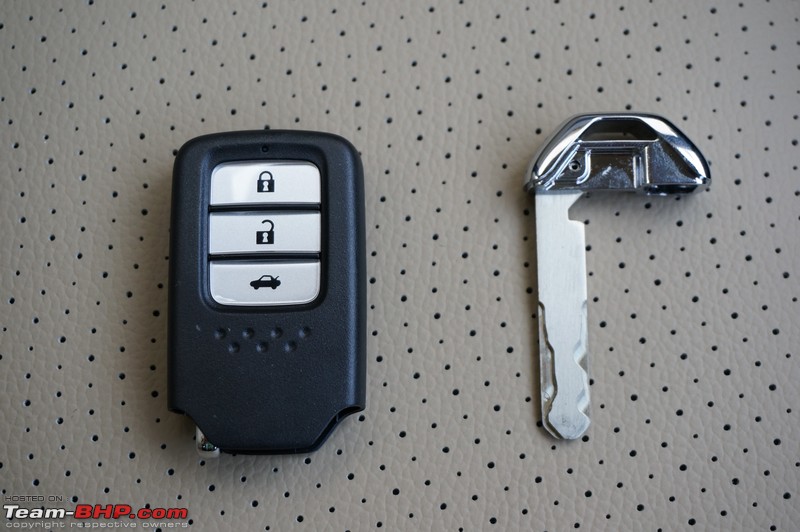 Naked fuse box?! Hopefully, production cars have a cover here. If not, that's an awful omission:  Useful storage drawer on the dashboard's RHS:  The City waited 15 long years for this badge. It's the only sedan in the segment that, so far, competed with a petrol-only armoury:  Euro-looking vents. No air volume control for the center vents:  To the leftmost side of the dashboard is the 3rd style of vents! This one has its airflow control on the side (rightmost vent has it below):  Rear floor mat has flaps & velcro for a proper fit:  As does the small center mat:  Yep, the rear window rolls all the way down:  Rearview mirror is adequately wide:  These covers (of the power & audio sockets) felt flimsy. In our test car, the one for the AUX input wouldn't stay up. I doubt they're going to last the distance:  Sunroof has one-touch open & close. Push the button upward for 'tilt' position:  A closer look at the driver's armrest:  Boot release lever placed similarly to the outgoing car:  Beige carpets are a big no-no for Indian conditions. Would've preferred black or dark grey instead. Also pictured here is the drain plug:  This ugly cut (on the carpet in the front passenger's footwell) is prominent and looks out of place. It was consistent across all 3 media cars that I drove:  Diesel stamped all of 3 times! Guess petrol pump attendants are so used to the City being a petrol:  Wide opening rear door:  Steering is adjustable for tilt only. Wish Honda had given reach too. I found the location of this adjustment lever to be too far down:  The tall front neck restraints:  Zooming in on the thin (front) door pocket. The opening is simply too slim and those with heavier hands will have trouble picking stuff out of here. Limited capacity & usability:  The climate control's solar sensor placed on the dashboard:  Look at this removable panel above the audio sockets. Sometimes, the A/C temp sensor is housed behind such a cut-through. A company official says there's nothing in the Indian City though; it might have something to do with a feature for other markets:  6 colour options, including this new 'Golden Brown Metallic':  Dark body shade conceals design highlights, white / silver make them more obvious: 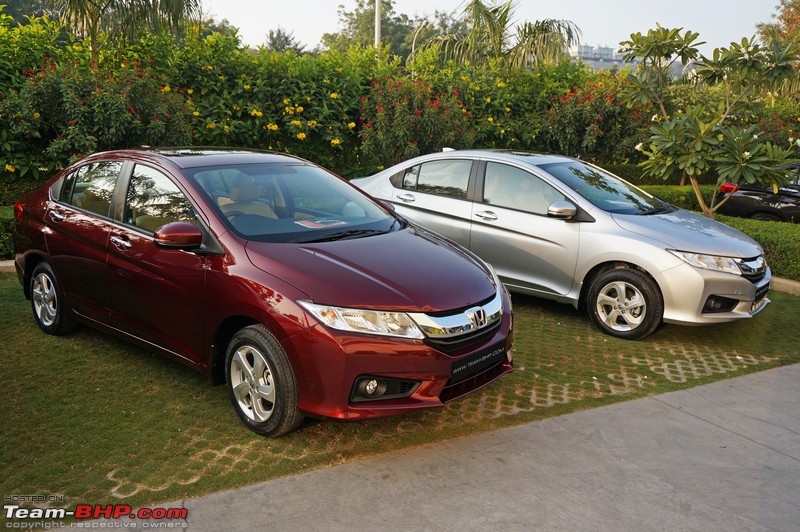 Last edited by GTO : 21st December 2013 at 09:15. |
| |  (71)
Thanks (71)
Thanks
|
| The following 71 BHPians Thank GTO for this useful post: | 100kmph, 9thsphinx, akshay81, AutoIndian, autonarr, avdhesh15, Bailey, BlazzingInferno, bsdbsd, deetjohn, dkaile, DrPriyankT, echo77, ecosport rules, Gannu_1, Grace, hiren.mistry, horabonny, H_Dogg72, iliketurtles, InControl, Insearch, J.Ravi, JoseVijay, kevintomin, Kimified, kiren, kryogesh, Maky, manim, Mevtec, MotorDev, noopster, prakhar1998, punkuz, Rajeevraj, rajesh1868, Ranjit.Shetty, RavenAvi, Rehaan, Rohit Manohar, romeomidhun, RSR, S.MJet, saket77, Satshan, sa_kiran, scopriobharath, Sheel, Shreyas Aterkar, Simhi, SmartCat, suhaas307, swiftnfurious, Tats07, Technocrat, tejas08, tharian, theexperthand, TheTeacher, thoma, ToroRosso, uday.ere, vaish9925, valapad, vb-saan, vhharan1, vibbs, Voodooblaster, WAM-4, zalaps |
| | #10 |
| Team-BHP Support  | re: 4th-gen Honda City : Official Review Chief Competitors of the Honda City Hyundai Verna What you'll like: • A great looking Hyundai sedan • Well-packaged; sufficient room front & back • Competent 1.6L powerplants, especially torquey diesel. Wide range of engines & transmissions on offer • Ride quality & behaviour in the city • Impressive feature list (reversing camera, keyless entry & go, electric folding mirrors and more) • Top notch safety equipment including 6 airbags, ABS + EBD, all wheel disc brakes etc. What you won't: • Dynamics & high speed handling. Softly tuned suspension • High speed ride quality isn't flat. Suspension, especially on uneven roads, gets wallowy • 4 speed Automatic gearboxes. This segment calls for a 5 speed • Under-thigh support of the low rear seat not as good as that of competition Volkswagen Vento What you'll like: • A well-built, robust, European sedan • Clean and contemporary styling. Boot is superbly integrated • Stunning diesel engine & excellent 1.2L turbo-petrol • Mature suspension setup. Balanced ride & handling • Segment firsts : Reach adjust steering, gear recommender, adjustable driver armrest etc. • All-rounded nature; Jack of all trades What you won't: • 1.6L petrol engine isn't impressive. Average low rpm response • Electric power steering. The Vento deserves a pure hydraulic unit • Quite a loud & clattery diesel engine • Feature list is poorer than that of the City & Verna • Tall rear floor hump makes the Vento more suited as a 4 seater, than 5 • VW's sub-par dealership & service experiences Skoda Rapid What you'll like: • A well-built European car • Better package than the Vento at a lower, VFM price • Superb diesel engine; good driveability and 250 Nm of torque • Mature ride & handling setup • Confidence inspiring dynamics, brakes and chassis • Easy to drive Automatic transmission. Different modes to suit your style of driving What you won't: • Skoda's scary after-sales-service • Not as feature laden as the competition • Sluggish "D" mode of the Automatic gearbox. Also, no Automatic option for the diesel engine • 1.6L petrol engine isn't as impressive as the diesel • Tall rear floor hump makes the Rapid more suited as a 4 seater, than 5 • Electric power steering. The Rapid deserves a pure hydraulic unit Ford Fiesta What you'll like: • Futuristic front-end & stylish dashboard design • Great feature set including voice activation, auto-fold mirrors, cruise control, and more • ABS and Dual-airbags are standard across the range, including the entry variants • Ford’s torquey, fuel-efficient diesel engine • Excellent driving dynamics and impressive steering feel for an EPS What you won't: • A market flop. Initial pricing strategy killed the car • Disproportionate rear end due to excessive bulk behind the rear wheel arches • Interiors at the rear look and feel like they are from a segment lower • Lackluster petrol engine, a disappointment for enthusiasts when compared to the old 1.6 • At low speeds, the suspension firmness accentuates the imperfections of the road Fiat Linea What you'll like: • Stunning looks & "vault-like" build • Turbo-charged petrol makes the Linea extremely satisfying to drive • Best-in-class ride comfort, handling & dynamics package • Perfectly calibrated & weighted power steering • T-Jet's A+ braking capability. All-round disc brakes a segment first • Top level of equipment (including leather seats, Blue&Me, rear air-con and more) What you won't: • Under-powered diesel. Slower than all C2 competitors • Rear seat is the least spacious from this segment. 5 an impossible fit • Awkward driving position and ergonomics • Interior quality, fit & finish still have rough edges • Niggling issues & irritants (as reported by existing Linea / Punto owners) • Below average after-sales service quality |
| |  (78)
Thanks (78)
Thanks
|
| The following 78 BHPians Thank GTO for this useful post: | achyutaghosh, ajitsank, akshay81, amolbh, Apple, arishi1, arsenal.arun, AutoIndian, avdhesh15, B103, Batfreak, bharatbs, BlazzingInferno, Digital Vampire, dkaile, dnahelix, echo77, ecosport rules, Eminenttismo, execve, Gannu_1, hiren.mistry, horabonny, Hulk, H_Dogg72, iliketurtles, InControl, iVento, JayD, Jeash.vk, JoseVijay, kryptonite, Madan Gopal, Maky, membersree, modisan, MotorDev, nalinsaxena23, nkghai, R2D2, RavenAvi, redracham, RemingtonSteele, rishie, Rohit Manohar, RSR, S.MJet, sagarrungta, saket77, Santoshbhat, Satshan, sa_kiran, scopriobharath, shipnil, Shome, Sir"CAR", stringbh, suhaas307, swiftnfurious, tamsaif, Technocrat, tejas08, Tejas@perioimpl, The Great, theexperthand, ToroRosso, uday.ere, vaish9925, valapad, vb-saan, vibbs, Voodooblaster, vvrchandra, WAM-4, Yeldo, yogeshnagpal, zalaps, _raVan_ |
| | #11 |
| Senior - BHPian | re: 4th-gen Honda City : Official Review Damn! I didn't even expect this review. This is like a Christmas gift! Honda City, especially the prev version was one of my favourite cars. Waiting to relax and read this review. Thanks GTO. |
| |  (1)
Thanks (1)
Thanks
|
| The following BHPian Thanks tharian for this useful post: | R2D2 |
| |
| | #12 |
| BHPian Join Date: Nov 2013 Location: TN-22
Posts: 151
Thanked: 156 Times
| re: 4th-gen Honda City : Official Review As usual, a nice review and a much awaited one. However, the pricing needs to be seen. That's when the rat race begins. |
| |  (1)
Thanks (1)
Thanks
|
| The following BHPian Thanks Srikanthan for this useful post: | R2D2 |
| | #13 |
| BHPian | re: 4th-gen Honda City : Official Review That's a great review. Much awaited for the new car buyers, as the City diesel is going to shift a considerable number from it's contenders. And, IMHO, the alloy wheels are completely outdated and looks like more of a wheel cover from a distance. In fact, the ten spoke alloys of the outgoing Honda City gave the car a much better look. |
| |  (1)
Thanks (1)
Thanks
|
| The following BHPian Thanks mksureshhere for this useful post: | GTO |
| | #14 |
| BHPian Join Date: Jun 2011 Location: Bangalore
Posts: 61
Thanked: 91 Times
| re: 4th-gen Honda City : Official Review Thanks GTO for this wonderful review, your attention to details is simply great ! |
| |  (3)
Thanks (3)
Thanks
|
| The following 3 BHPians Thank venks for this useful post: | GTO, Maky, Voodooblaster |
| | #15 |
| Senior - BHPian | re: 4th-gen Honda City : Official Review Fantastic and detailed review! Like I also mentioned before, this is not the City which will electrify the auto industry like it did in 2008. The diesel engine is bit disappointing. If I have to choose between the diesel and petrol variant, I will any day choose i-VTEC variant - petrol prices be damned! Still this will sell in good numbers for obvious reasons - City is best in terms of space, style and premium-nes. Diesel engine is added advantage for the mile crunchers. I don't think they will provide factory fitted CNG kit with this one, as it might cannibalize diesel sales! 2008 Honda City also had Speed sensitive audio system. I hope they price the 2014 City well. Last edited by bluevolt : 17th December 2013 at 18:23. |
| |  (3)
Thanks (3)
Thanks
|
| The following 3 BHPians Thank bluevolt for this useful post: | GTO, vishy76, Voodooblaster |
 |


